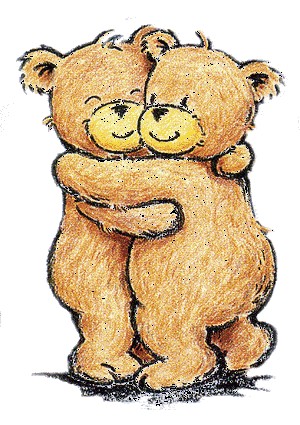I experience one of life’s greatest pleasures when a child hugs me. Warm fuzzies head to toe in less than two seconds. When I was a child, hugging adults usually conveyed a familial or extended family relationship, and joy for the adult’s presence. And like many other children, there were occasions when I needed a hug so I could be calmed: when the wasp stung me, when leaving home, when my grandmother died. I now understand how much the hug gives to an adult. Adults also receive a sense of dependence, fulfillment, comfort and joy from the hugs. In hugs, we absorb and diffuse pain; project and receive comfort; greet and celebrate, mourn and shudder. It’s one of the few, quick-and-easy, forms of mutuality in my life. Hugging creates empathy.
So I can understand how difficult it is when many parents and guardians go through the stage where they must let their child cry themselves to sleep. After days, weeks and months of jumping at every cry, searching for the source of alarm, and learning the differences among a “hungry cry,” a “tired cry” and “I’m-scared-without-you cry.” Now, many experts say, “Let the child cry.”
It goes against this basic maxim that Paul writes about in a letter to an early Christian community in Rome: “Rejoice with those who rejoice; weep with those who weep” (Romans 12:15).
Sometimes we need to be reminded to form community. Sometimes we need gentle prodding to remember that we are our brother’s and sister’s keepers. Sometimes a short scripture goads us into reaching out and hugging someone. Although we may need to hear these words repeated, it seems like an acceptable – even if ideal – rule by which to live in faith, family and friendship.
The idea of letting a child cry himself to sleep can often grate against the empathy we’ve developed.
Those who advocate this practice refer to it as “self-soothing.” One puts a child into her own bed or crib when she’s awake, and let’s her soothe herself to sleep – without the rocking, cuddling or cooing of the loving adult. The child often protests because it’s a new experience, the constant comforter seems to be gone, and she hasn’t yet developed the skill to calm herself. So the child cries and cries and cries. And the loving adults must quell the desire to run to the child. They need to let the child cry it out. They must trust that the need to sleep will compel the child to find a way to comfort herself. It’s a way of helping children to mature.
I have found that this is not just a skill that tired babies must learn. It’s a skill that I’ve had to learn and re-learn myself. The angst of adolescence, the grief of missing deceased loved ones and the chronic emotional pain of depression mean that I have cried myself to sleep on more occasions that I can count. Most of the time, this has come from necessity – not a desire to be mature and to comfort myself.
As a person living with a depressive condition, anguish can be a frequent visitor. If I had it my way, I’d share it to dissipate its power, lean on the most dependable of friends, and have someone come in and rock me when I’m scared, can’t sleep or something new seems daunting. Intellectually, I’ve known that’s not possible. Emotionally, it’s been a constant craving.
One therapist pointed this out to me when she said, “You have to learn to do for yourself what you are asking other people to do for you.” I knew what she meant. I wanted “other people” to comfort me. To rock me and to hold me and to tell me that it’s going to be okay. My therapist’s point was simple, but it wasn’t easy.
I had huge emotional expectations for some of the closest people in my life. That had to stop. I had to strip the co-dependent relationships from my life. Don’t call them at 2 am to talk me through the nightmare. Don’t call them to come over and watch me sleep. Don’t ask them to hold me together when I’m falling apart. That was too much to ask. It wore people out. It was too much of a task for any one person to manage. And I would always be disappointed because no one can do that perfectly.
So I learned. I learned to curl up in a ball, wrap my arms around each other with my hands on my shoulders. And rock. And imagine that some one – some Spirit, an imaginary friend, my Mama, God – was rocking me. Pulling the hair back from my eyes and rocking me and saying, “Shh, baby. It’s going to be okay. Shh. It’s going to be okay.”
This became something I could invoke in the middle of the night – and there are always “middle of the night” moments. I rocked myself to sleep. I cried it out. I soothed myself.
This worked for years and years. This was my silent personal way of living with some of the inexplicable far-too-often nighttime pains of living with a depressive condition.
One difficult night, I invoked my normal routine. I had awakened from a dream in an anxiety attack. Even while sleeping, my mind was reviewing all the stressors in my life – magnifying them into insurmountable tasks. Short of breath, I started rocking. I curled into the fetal position and began speaking to myself. My “Shhs” were probably audible. I invoked every breathing technique I had learned from yoga, chiropractic care, spiritual meditation, and respiratory integration. These are some of the practices that keep me well and calm in daylight hours. “Shh,” I said between hyperventilating breaths.
It did not work. And in that moment, I knew what had died.
This is part one of three parts. The next part will be posted next week.
* * *
my survivor strategies
Connect with me on facebook







Look forward to the completion of the trilogy. As you enter my home, in the foyer, on a small end table (which belonged to my mother-inlaw), sites a teddy bear with a message written on its heart: “Hugs Please”.
Yes, Yes, I know. Dom dom dom dom dom dom dom, dom dom dom dadom dom dom dom dom dom dom dadom dom da dom da dommmm dommmm.